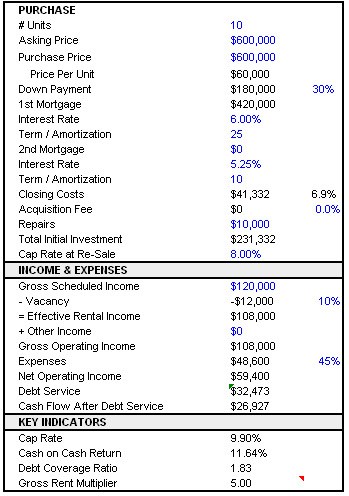Some of you have me asked questions like, “How is it possible to make a deal with investors not only cash flow but achieve 13%+ returns for the investors? I can’t even seem to make this work with a 10% cap rate!”
Certainly, when you’re sharing the pie with others, it should be big enough to share. In this article, I want to show you that a 10-cap deal is big enough to share, leaving a good return for you and your investors.
While we should look for deals to which we can add value to (and maybe double the value of the building in 3-5 years), let’s pick a “boring” 10 cap deal with no particular upside. If it works with something like this, then it should work even better with something with an upside.
Let’s Begin Our Case Study
Assume we’re buying a 10-unit apartment building at a 10% cap rate on actual financials. The average rent per unit is $1,000 per month and increases by 3% per year. The historic vacancy rate is 10%. We’ll need $1,000 per unit in renovations. Our expenses will be 45% of income and those will increase 3% per year.
This puts our net operating income (NOI) at just about $60,000. To buy this at a 10% cap rate, we will pay no more than $600,000.
Pretty normal stuff so far, nothing out of the ordinary.
Because we will be syndicating this with a handful of investors, our attorney fees will be substantially higher than a “normal” deal. For example, we need to pay for a “Private Placement Memorandum” (PPM) to comply with SEC securities laws, and that can get expensive (my attorney charges me $6,000 but it’s common to cost more than that). Largely because of this, my estimated closing costs are $41,000, a hefty number, but I use it to be realistic and also to demonstrate that the deal still works even with that kind of expense.
Related: The Benefits and Challenges of a Real Estate Syndication
A Summary of What We Have So Far
You can see that the cap rate is just about 10% and is yielding a cash on cash return of a little less than 12% (given the $230,000 of equity we put into the deal).
Obviously, if you didn’t require investors and you could do the deal yourself, great! But I’d like to show you how this deal can produce a reasonable return for you and your investors, even if you didn’t use any of your own capital.
Let’s say you structured the deal such that the investors get 75% of the building and you gave yourself 25% for putting the whole thing together. (In general, I need the deal to work with me owning at least 20% of the building, otherwise it may not be worth it for me).
Based on our financials above, the net operating income in the first year is $60,000. This leaves about $27,000 of cash to distribute after debt service of $32,000. The investors receive 75% of the cash available after debt service, which is $20,000 or a 9% cash-on-cash return.
So far, this is a GREAT cash-on-cash return for the investors! What about any profits from a re-sale down the road? Let’s assume we sell the building after five years at the same cap rate when we bought it (10%). As we said earlier, our rents and expenses both rise by 3% per year. I plug these numbers into my 5 year financial projections and I see that the NOI will be $67,000 after the 5th year. At a 10% cap, the building’s value is $670,000. Our tenants have paid down about $42,000 in principal during this time. So we’ve added a little bit of value in 5 years (but not much).
Adding together distributions, loan amortization and appreciation, our investors’ average annual return is 11%.
This is certainly not an incredible return but consider that this is for an extremely stable asset. Investors today are very interested in investing with you for a stable, compounded return like this. I have found that in general, investors will invest for an 11% to 15% average annual return.
Related: Syndication: Is It Even Worth The Trouble?
Conclusion
I hope I’ve made the point that you can syndicate a “boring” old 10 cap deal with no upside whatsoever.
However, we should strive to and can in fact do better than that!
If we could increase rents by just $100 per unit per month in the second year (and then increasing by 3% after that), our crafty syndicated deal analyzer shows us that the average annual return for the investors jumps to 15%. Now that’s better!
Let’s not forget about ourselves, the hard-working apartment building syndicator. Our boring 10-cap pays us an average of $10,000 per year in cash flow and a little bit at closing. Not shabby for not having any of our own money in the deal and having a property management company run the whole thing.
Questions? Comments?
I’d love to answer questions about making syndicated deals work for your investors as well as for yourself!




